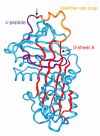Hereditary alpha-1-antitrypsin deficiency and its clinical consequences
- PMID: 18565211
- PMCID: PMC2441617
- DOI: 10.1186/1750-1172-3-16
Hereditary alpha-1-antitrypsin deficiency and its clinical consequences
Abstract
Alpha-1-antitrypsin deficiency (AATD) is a genetic disorder that manifests as pulmonary emphysema, liver cirrhosis and, rarely, as the skin disease panniculitis, and is characterized by low serum levels of AAT, the main protease inhibitor (PI) in human serum. The prevalence in Western Europe and in the USA is estimated at approximately 1 in 2,500 and 1 : 5,000 newborns, and is highly dependent on the Scandinavian descent within the population. The most common deficiency alleles in North Europe are PI Z and PI S, and the majority of individuals with severe AATD are PI type ZZ. The clinical manifestations may widely vary between patients, ranging from asymptomatic in some to fatal liver or lung disease in others. Type ZZ and SZ AATD are risk factors for the development of respiratory symptoms (dyspnoea, coughing), early onset emphysema, and airflow obstruction early in adult life. Environmental factors such as cigarette smoking, and dust exposure are additional risk factors and have been linked to an accelerated progression of this condition. Type ZZ AATD may also lead to the development of acute or chronic liver disease in childhood or adulthood: prolonged jaundice after birth with conjugated hyperbilirubinemia and abnormal liver enzymes are characteristic clinical signs. Cirrhotic liver failure may occur around age 50. In very rare cases, necrotizing panniculitis and secondary vasculitis may occur. AATD is caused by mutations in the SERPINA1 gene encoding AAT, and is inherited as an autosomal recessive trait. The diagnosis can be established by detection of low serum levels of AAT and isoelectric focusing. Differential diagnoses should exclude bleeding disorders or jaundice, viral infection, hemochromatosis, Wilson's disease and autoimmune hepatitis. For treatment of lung disease, intravenous alpha-1-antitrypsin augmentation therapy, annual flu vaccination and a pneumococcal vaccine every 5 years are recommended. Relief of breathlessness may be obtained with long-acting bronchodilators and inhaled corticosteroids. The end-stage liver and lung disease can be treated by organ transplantation. In AATD patients with cirrhosis, prognosis is generally grave.
Figures







Similar articles
-
Frequency of alleles and genotypes associated with alpha-1 antitrypsin deficiency in clinical and general populations: Revelations about underdiagnosis.Pulmonology. 2023 May-Jun;29(3):214-220. doi: 10.1016/j.pulmoe.2022.01.017. Epub 2022 Mar 26. Pulmonology. 2023. PMID: 35346640
-
Liver Fibrosis and Metabolic Alterations in Adults With alpha-1-antitrypsin Deficiency Caused by the Pi*ZZ Mutation.Gastroenterology. 2019 Sep;157(3):705-719.e18. doi: 10.1053/j.gastro.2019.05.013. Epub 2019 May 20. Gastroenterology. 2019. PMID: 31121167
-
The Distribution of Alpha-1 Antitrypsin Genotypes Between Patients with COPD/Emphysema, Asthma and Bronchiectasis.Int J Chron Obstruct Pulmon Dis. 2020 Nov 6;15:2827-2836. doi: 10.2147/COPD.S271810. eCollection 2020. Int J Chron Obstruct Pulmon Dis. 2020. PMID: 33192056 Free PMC article.
-
Alpha1-antitrypsin deficiency: An updated review.Presse Med. 2023 Sep;52(3):104170. doi: 10.1016/j.lpm.2023.104170. Epub 2023 Jul 29. Presse Med. 2023. PMID: 37517655 Review.
-
Pulmonary manifestations of alpha 1 antitrypsin deficiency.Am J Med Sci. 2024 Jul;368(1):1-8. doi: 10.1016/j.amjms.2024.04.002. Epub 2024 Apr 9. Am J Med Sci. 2024. PMID: 38599244 Review.
Cited by
-
Treatment of severe stable COPD: the multidimensional approach of treatable traits.ERJ Open Res. 2020 Sep 21;6(3):00322-2019. doi: 10.1183/23120541.00322-2019. eCollection 2020 Jul. ERJ Open Res. 2020. PMID: 32984420 Free PMC article. Review.
-
Proteolysis and Deficiency of α1-Proteinase Inhibitor in SARS-CoV-2 Infection.Biochem Mosc Suppl B Biomed Chem. 2022;16(4):271-291. doi: 10.1134/S1990750822040035. Epub 2022 Nov 16. Biochem Mosc Suppl B Biomed Chem. 2022. PMID: 36407837 Free PMC article.
-
The Mechanism of Mitochondrial Injury in Alpha-1 Antitrypsin Deficiency Mediated Liver Disease.Int J Mol Sci. 2021 Dec 9;22(24):13255. doi: 10.3390/ijms222413255. Int J Mol Sci. 2021. PMID: 34948056 Free PMC article.
-
Identifying Alpha-1 Antitrypsin Deficiency Based on Computed Tomography Evidence of Emphysema.Cureus. 2019 Jan 28;11(1):e3971. doi: 10.7759/cureus.3971. Cureus. 2019. PMID: 30956923 Free PMC article.
-
An RNA structure-mediated, posttranscriptional model of human α-1-antitrypsin expression.Proc Natl Acad Sci U S A. 2017 Nov 21;114(47):E10244-E10253. doi: 10.1073/pnas.1706539114. Epub 2017 Nov 6. Proc Natl Acad Sci U S A. 2017. PMID: 29109288 Free PMC article.
References
-
- Brantly M, Nukiwa T, Crystal RG. Molecular basis of alpha-1-antitrypsin deficiency. Am J Med. 1988;84:13–31. - PubMed
Publication types
MeSH terms
Substances
LinkOut - more resources
Full Text Sources
Other Literature Sources
Medical
Research Materials
Miscellaneous

